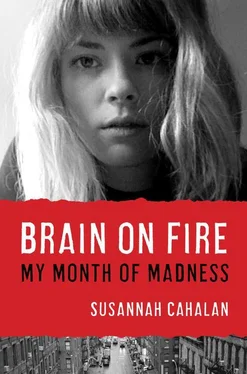“I hear voices,” another person said. “There are people out to get me. Just like you.”
One woman who sounded manic, her pressured speech hard to understand, called several times a day, trying to arrange a meeting so that I could diagnose her myself.
“I’m not a doctor, but you should contact these people,” I said, providing these callers with the list of doctors who had treated me. But the truth was, the only difference between those suffering from schizophrenia and me was that I was cured. Like these people, I knew exactly what it was like to be caught in the prism of your own fractured psyche.
Survivor’s guilt as a kind of posttraumatic stress disorder (PTSD) is common—a study indicates that 20 to 30 percent of survivors develop it—and it has been documented in those with cancer and AIDS, as well as war veterans. 59I can sincerely relate to this feeling, even though in some ways, my problem is the opposite of PTSD: whereas most PTSD sufferers are desperately trying to escape their memories of the original trauma, I have none.
But still the guilt remains, especially when I speak to families who cannot help but feel resentful. There was a newlywed who called me about his wife; he had e-mailed me on Facebook, and I gave him my number. “How do you know you won’t get sick again?” he asked, aggressively.
“I don’t know. I really can’t answer that.”
“How can you be sure?”
“I can’t be. This is just what the doctors are telling me.”
“And how come you got better while my wife is still sick, even though she was diagnosed before you?”
“I, I don’t know.”
Two weeks later, he called me back. “She’s dead. She died last week. I thought you should know.”
There had been no miracle diagnosis for his wife. And there is not a miracle diagnosis for everyone. There doesn’t seem to be any logic to it; it’s the luck of the draw, as unfair and callous and, frankly, terrifying as that may sound. Even if the disease is properly treated, there is still about a 25 percent chance that someone with it will be permanently disabled or die.
But there are many more interactions that I’ve had in the wake of this illness that have turned this terrible disease into some sort of gift—not one that I would bestow even on my worst enemy but a gift nonetheless.
I became close to a woman named Nesrin Shaheen, whose preteen daughter developed the illness around the time that I did and now works tirelessly to spread awareness, devoting countless hours to a Facebook page on anti-NMDA receptor encephalitis that helps hundreds of people navigate the lonely illness. In addition to Nesrin’s Facebook page, many other sites are devoted to spreading the word and connecting patients and families so that they don’t have to go through this ordeal alone.
. . .
The most affirming moment of my entire life—and to be able to say this with absolute certainty is just another example of how this disease has changed my perspective in positive ways—was when a man named Bill Gavigan called me in spring 2010.
“Is this Susannah Cahalan?” he asked breathlessly.
“Yes,” I said, taken aback. People usually did not say my name as if it carried such weight. He went on to tell me the story of his teenage daughter, Emily.
One day when she was a sophomore at a Pennsylvania college, Emily suddenly started speaking rapidly and became paranoid that pickup trucks were following her, communicating her whereabouts to each other on walkie-talkies. The next day, when they were headed to a Broadway show in New York, Emily became fixated on the cars around them. She insisted that they were being tailed, which so worried Bill and his wife, Grace, that they immediately turned the car around and headed straight to the ER. In the hospital, Emily’s paranoia intensified because the ER doctor reminded her of her high school history teacher, which convinced her that he was an imposter, an actor playing the part of a doctor—exactly what had happened to me with my father and the EEG nurse.
Emily admitted herself into a psychiatric ward, where she stayed on observation without any contact with her family for seventy-two hours. She was put on a litany of mood stabilizers and antipsychotics and remained in the ward for another two weeks before she was released with the diagnosis of “psychosis, not otherwise specified,” medical jargon for “we have no clue.”
Although she was heavily sedated, she insisted on returning to school. But then her parents received a call from the dean of students, expressing grave concern over Emily’s erratic behavior. She returned home, and for the next few weeks was shuffled back and forth between her parents’ house and the local psychiatrist, until she was admitted to the Psychiatric Institute of Pennsylvania for three weeks. Bill compared the experience to the movie One Flew Over the Cuckoo’s Nest . Though they did not have a diagnosis yet, the psychiatrist told her parents that he was leaning toward schizophrenia, even after other neurologists had offered a possible diagnosis of multiple sclerosis. The social worker there advised them to sign her up for social security disability because “she’s never going to be able to work.” Bill refused to believe that and threw the social security forms in the trash after she left.
It was around this time that Bill’s sister, Mary, saw me on the Today show (after a producer who saw the Post piece invited me on for a segment). She sent the video to Bill, who passed it and my Post article along to Emily’s psychiatrist.
“She didn’t have seizures,” said the psychiatrist, pointing out the discrepancies between my case and Emily’s. He seemed genuinely insulted by the implication that he had missed something. “You have to come to terms with the fact that you have a daughter with mental illness.”
After twenty-one days at the institute, Emily went through outpatient treatment and eventually returned to school yet again, completing the semester with good grades even though her parents still believed she wasn’t 100 percent well.
It appeared that she had overcome the problem, whatever it had been, until she came home for spring break, when her physical and cognitive issues suddenly got dangerously severe. Bill noticed that she could no longer solve simple math problems; Grace watched her daughter try to eat a pint of ice cream, almost unable to hold her spoon. Then, suddenly, she went from speaking too fast to not speaking altogether.
She was rushed to the nearby hospital, where the doctors informed Emily’s parents that an MRI from a year ago had shown inflammation, a fact that had never been shared with the Gavigans before. As the doctors prepared for an aggressive treatment of IVIG, which helps with inflammation, Emily developed a blood clot in her brain, which caused her to seize for an hour and a half.
While Emily was convulsing in the next room, Bill thrust my article into the on-call neurologist’s hands.
“Read this. Now,” he commanded.
The doctor read through it right in front of Bill, placed it in his pocket, and agreed to test her for this rare autoimmune disease.
As soon as she could be moved, Emily was air-evacuated to the University of Pennsylvania, where Dr. Dalmau’s colleagues diagnosed her and began treatment for anti-NMDA-receptor encephalitis. Through an aggressive regimen of steroids and chemotherapy, Emily has returned full time to college. She is 100 percent healthy now and in 2012 finished her final semester of college.
On the phone to me, her father said, “I don’t want to be, well, I guess there’s no way other than to be very dramatic about it. But I’m not kidding, if we didn’t have that article to hand to the doctor, she’d be dead.”
Читать дальше












